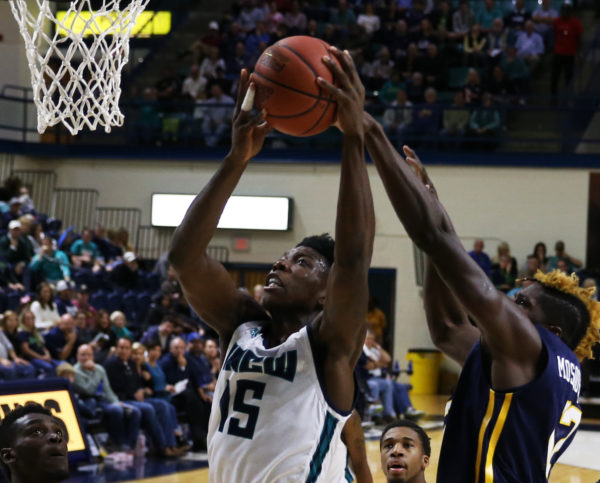Balance and Efficiency Taking UNC Wilmington to New Heights
Posted by Tommy Lemoine on January 18th, 2017Perhaps no box score better encapsulates UNC Wilmington this season than its 101-77 drubbing of William & Mary last Wednesday. By night’s end, six Seahawks had reached double figures—three with 18 points, two with 14 and one with 11—as the team shot a blistering 70 percent from inside the arc and forced 17 turnovers. It was the second straight game in which five players eclipsed double-figures, and the fourth time this season that UNC Wilmington had scored 100. Put simply, Kevin Keatts’ unit pushed the pace, created good looks and capitalized more often than not. Now 17-2 and ranked #43 in KenPom‘s ratings, the Seahawks seem destined to surpass last year’s record-tying 25 wins and first-round NCAA Tournament appearance. With one of college basketball’s most balanced and efficient lineups, they have legitimate second weekend potential.

Devontae Cacok has been a revelation for UNC Wilmington this season. (Photo by John Crouch)
Taking care of (and simply taking) the basketball. If stellar guard play is the mark of a true Cinderella, then UNC Wilmington certainly fits the bill. Keatts starts four guards—Denzel Ingram, Ambrose Mosley, Chris Flemmings and CJ Bryce—three of whom are seniors and all of whom can handle the ball. All that experienced ball-handling has helped the Seahawks post the second-lowest turnover rate in the country at 13.8 percent, a level of mistake-free prowess put on full display last week: In 143 combined possessions against William & Mary and Hofstra, UNC Wilmington suffered just 11 turnovers. Conversely, its defense has been especially aggressive this season, forcing turnovers at its highest rate ever (23.2%, 13th nationally) under the Rick Pitino prodigy. On top of all that, the Seahawks don’t seem to care who shoulders the load. Bryce, the team’s best player (17.8 PPG, 3.2 APG), Flemmings (16.1 PPG) and Ingram (15.6 PPG) have each led the team in scoring multiple times this year, and UNC Wilmington remains the CAA’s only unit without a player who takes more than 25 percent of his team’s shots while on the floor. Combine balanced, mistake-free basketball with easy buckets from turnovers, and what do you get? One of the 20 most efficient offenses in college basketball.
Key pieces emerge. Of course, these elements alone don’t account for the Seahawks’ surge in offensive production—new blood has helped. The emergence of two key players—Mosley (7.8 PPG) and sophomore forward Devontae Cacok (13.3 PPG, 9.6 RPG)—have gone a long way toward helping UNC Wilmington score an eye-popping 1.17 points per possession this season. The former, a graduate transfer from Old Dominion, has proven to be outstanding three-point shooter (41% 3FG) and an adequate replacement for guard Craig Ponder (11.4 PPG in 2015-16). To this point, he has seen the court more often than junior Jordon Talley—a former starter who was suspended to start the year—enabling Keatts to play a more perimeter-oriented style than he did a year ago. The CAA front-runners take more of their total field goal attempts from behind the arc this season, and score almost six percent more points from that range.
It has been Cacok, though, who has made the biggest difference. As the team’s only true inside presence, the 6’7″ power forward has transformed from seldom-used freshman into remarkably-efficient sophomore over the course of just one year. He currently touts the highest field goal percentage (80.0% FG) and second-highest offensive rating (148.5 ORtg) in college hoops, shooting an absurd 110-for-135 from the field. Cacok also ranks among the top 50 players nationally in offensive and defensive rebounding percentage, while demonstrating active hands (1.2 SPG, 1.1 BPG) on defense. His athleticism and knack for finishing at the rim are ideal for a transition-oriented team that feeds off the pick-and-roll in the half-court. Cacok’s 11 made dunks against Division-II Pfeiffer University on December 3 crushed the school record by six. “He doesn’t have to have the ball to get his points. And that’s the great thing—he doesn’t demand it, he’s always around the rim,” Keatts said of his burly sophomore earlier this season. Cacok’s emergence—along with the addition of Mosley and an improved Bryce—has helped UNC Wilmington’s offense go from good to elite.

Former Louisville assistant Kevin Keatts has taken the Seahawks to new heights. (Matt Miller/StarNews)
It won’t be easy. For as efficient, explosive, and downright excellent as UNC Wilmington has been this season, the team is not without some flaws. Most glaringly, the Seahawks—which rank 337th nationally in bench minutes—have real depth issues, especially in the frontcourt. Cacok has fouled out six times this season, one of which resulted in a loss (Clemson) and two of which were close calls (at Eastern Kentucky; vs. Evansville). Reserve big men Matt Bryan and Chuck Ogdobo, while serviceable in spots, simply can’t match Cacok’s athleticism and spark.
What’s more, the CAA is home to some very legitimate challengers this season—namely, College of Charleston and Northeastern. The three-point-happy Huskies—already with road wins at Connecticut, Vermont, Michigan State and Oakland—have arguably the league’s best player in point guard TJ Williams (21.4 PPG, 5.8 APG). The Cougars, meanwhile, boast one of the country’s elite defenses, holding opponents to under 0.95 points per possession while scoring a significant chunk of their points at the free throw line—the type of aggressive strategy that could test UNC Wilmington’s depth. Remember: For the Seahawks to do some damage in this year’s NCAA Tournament, they first need to make it there. With an RPI around #30 but only one win against the RPI top 100, that would mean either dominating their CAA schedule (one, maybe two losses maximum) or winning the conference tournament—neither of which is a sure thing. The first step? A trip to Charleston on Thursday to take on the 15-4 (6-0 CAA) Cougars. A win on John Kresse Court would go long way towards helping UNC Wilmington reach its March potential.









































